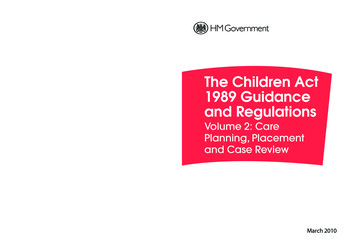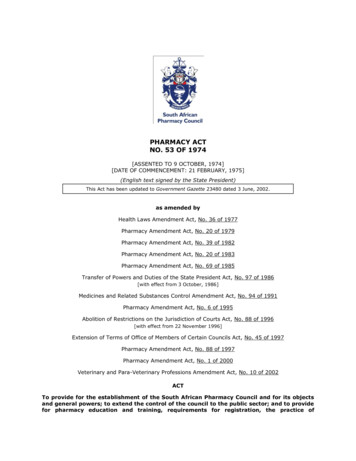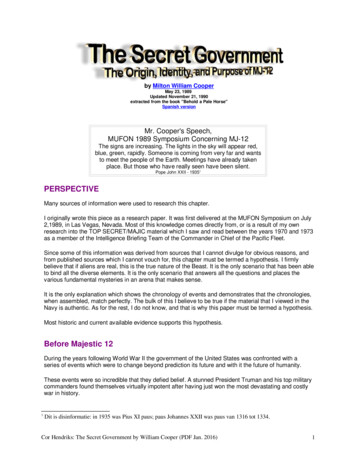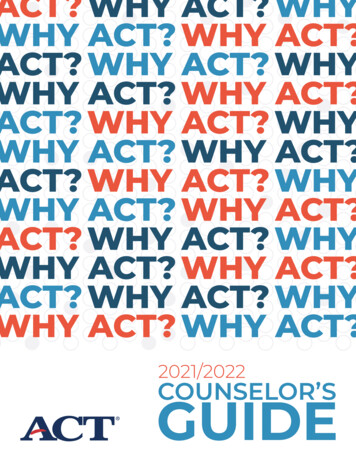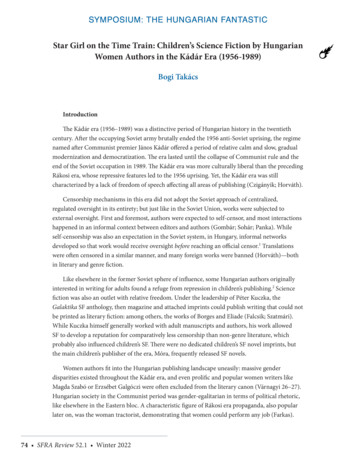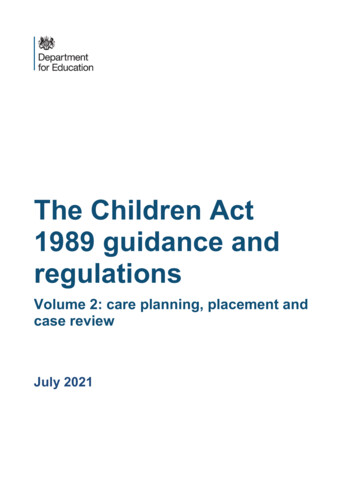
Transcription
The Children Act1989 guidance andregulationsVolume 2: care planning, placement andcase reviewJuly 2021
ContentsSummary5About this guidance5What legislation does this guidance refer to?5Who is this guidance for?5Main points71. Introduction8The Children Act 1989: key principles2.3.9The UN Convention and the European Convention on Human Rights10The child’s wishes and feelings10Corporate parenting and multi-agency involvement11The legal context12The looked after child12Overview of the legislation and regulations in relation to this guidance15Care Planning19The purpose of care planning and review19Permanence planning19The relationship between the care plan and other plans21Arrangements for looking after a child28Arrangements for contact38The role of the IRO in improved care planning43Placement47Placement under the 1989 Act47The placement decision for an individual child48Provision for different types of placement62Temporary approval of a connected person68Placement of children with foster carers who are also approved prospective adopters80Placement plans88Types of decision942
Requirements to promote a strategic approach to placements105Independent visitors1074. Case review115Policy on reviews115Timing of reviews115Links with other reviews117Preparation117The conduct of the review117Duties of the IRO in the review process1245. Ceasing to look after a child6.128Children accommodated under section 20128Considering ceasing to look after a child129Eligible children – transition to adulthood130Short Breaks136The legal basis for short breaks136Care planning, placement and review in relation to a planned series of short breaks 141Planning requirements where regulation 48 applies141Visits where regulation 48 applies143Review requirements143The role of the independent reviewing officer1447. Case records145Establishing the child’s record145Retention and safekeeping146Access and confidentiality1478. Looked after children in contact with youth justice services148Responsibilities148Looked after children who have been arrested149Looked after children charged with an offence150Children not currently looked after150Children who are remanded151Looked after children who are convicted1603
Requirements following sentence161Custodial sentences163Annex 1: The statutory framework for care planning173Annex 2: Overview of the care planning, placement and review process175Annex 3: Dimensions of developmental need176Health176Education177Specific guidance on care planning arrangements in relation to education is set out atparagraphs 2.65 to 2.77. Family and social relationships178Emotional and behavioural development179Identity180Social presentation181Self-care skills181Annex 4: Suggested information for discussion between authorities when planning distantplacements183Basic information about the child183Plans for the child’s care183Services to support the child184Annex 5: Delegating authority to foster carers – things you need to know185Annex 6: A model for joint planning and practice187Annex 7: Changes to care status as a result of criminal justice decisions188Further information190Useful resources and external organisations190Other relevant departmental advice and statutory guidance190Other departmental resources1904
SummaryAbout this guidanceThis is statutory guidance from the Department for Education. It is issued as guidanceunder section 7 of the Local Authority Social Services Act 1970 which requires localauthorities in exercising their social services functions, to act under the general guidanceof the Secretary of State. This guidance should be complied with by local authoritieswhen exercising these functions, unless local circumstances indicate exceptional reasonsthat justify a variation.Volume 2 of the Children Act 1989 Guidance and Regulations provides guidance,primarily addressed to local authorities and their staff in England, about their functionsunder Part 3 of the Children Act 1989.What legislation does this guidance refer to? The Children Act 1989 The Care Planning, Placement and Case Review (England) Regulations 2010 asamended by:oThe Care Planning, Placement and Case Review and Fostering Services(Miscellaneous Amendments) Regulations 2013;oAdoption and Care Planning (Miscellaneous Amendments) Regulations2014;oThe Care Planning and Fostering (Miscellaneous Amendments) Regulations2015;oThe Care Planning, Placement and Case Review (England) (Amendment)Regulations 2021 The Legal Aid, Sentencing and Punishment of Offenders Act 2012 The Adoption Agencies Regulations 2005 (as amended by the Adoption and CarePlanning (Miscellaneous Amendments) Regulations 2014Who is this guidance for?This guidance is for: Local authorities Children’s services social workers;5
Supervising social workers; Frontline managers who have particular responsibilities in relation to looked afterchildren; Lead members in local authorities; Directors of children’s services; Managers of services for looked after children; Managers and staff of services to care leavers; Commissioners of placements and other services for looked after children; Virtual School Heads; Independent Reviewing Officers; Youth Offending Team managers and workers; Governors, Directors and Registered Managers of youth detentionaccommodation; Staff, including professionals providing education and health care, in youthdetention accommodation; Social workers based in Young Offender Institutions; Nominated officers; Officers who are responsible for carrying out the assessment and approval offoster carers who are already approved prospective adopters; Adoption agencies;It will also be relevant to: Children’s Trust partner agencies; Providers of services to looked after children, including private, voluntary andpublic sector providers; Foster carers and residential workers; Fostering agencies; Children’s services partner agencies with responsibilities for supporting lookedafter children – including professionals in schools, health services and youthjustice services.Looked-after children, care leavers and their families may also have an interest.6
Main pointsThis guidance updates and consolidates The Children Act 1989 Guidance andRegulations, Volume 2: Care Planning, Placement and Case Review documentspublished in March 2010. It now includes information contained in the following updatesand supplements: Delegation of Authority: Amendments to the Children Act 1989 Guidance andRegulations – July 2013 Looked-after children: contact with siblings – February 2014 Looked-after children and youth justice: Application of the Care Planning,Placement and Case Review (England) Regulations 2010 to looked-after childrenin contact with youth justice services – April 2014 Early permanence placements and approval of prospective adopters as fostercarers: Statutory guidance for local authorities and adoption agencies – July 2014 Out of authority placements of looked-after children – July 2014 Permanence, long-term foster placements and ceasing to look after a child –March 20157
1. Introduction1.1.Looked after children deserve the best experiences in life, from excellentparenting which promotes good health and educational attainment, to a widerange of opportunities to develop their talents and skills in order to have anenjoyable childhood and successful adult life. Stable placements, good healthand support during transition are all essential elements, but children will onlyachieve their potential through the ambition and high expectation of all thoseinvolved in their lives.1.2.This guidance sets out the functions and responsibilities of local authorities andpartner agencies under Part 3 of the Children Act 1989 (‘the 1989 Act’), whichconcerns the provision of local authority support for children and families. Inparticular it describes how local authorities should carry out their responsibilitiesin relation to care planning, placement and case review for looked after children.These responsibilities are designed to support the local authority in its primaryduty set out in section 22(3) of the 1989 Act to safeguard and promote thewelfare of the looked after child and to act as good corporate parents to enableeach looked after child to achieve his/her full potential in life.1.3.This guidance accompanies the Care Planning, Placement and Case Review(England) Regulations 2010 (‘2010 Regulations’), which bring together in a singleset of Regulations those duties which are at the heart of effective corporateparenting to improve the outcomes of looked after children, namely:1.4. placing the child at the centre of the work; effective care planning; ensuring that a child or young person is provided with accommodation whichmeets his/her needs; and ensuring that an effective review is conducted of the child’s case within thespecified timescales.This guidance is issued as part of a suite of statutory guidance which, togetherwith the 2010 Regulations, set out how local authorities should carry out the fullrange of responsibilities in relation to care planning, placement and review forlooked after children. Annex 1 shows how these and other documents fit togetherwithin an overall framework, the aim of which is to provide looked after childrenwith the most appropriate placement to meet their needs and improve theiroutcomes.8
The Children Act 1989: key principles1.5.1.6.1.7.A key principle of the 1989 Act is that children are best looked after within theirfamilies, with their parents playing a full part in their lives, unless compulsoryintervention in family life is necessary. That principle is reflected in: the concept of parental responsibility; the ability of unmarried fathers to share that responsibility by agreement withthe mother, by joint registration at birth or by court order; the local authority’s functions to provide services which support children andtheir families; the local authority’s duty to return a looked after child to his/her family unlessthis is against his/her interests; and the local authority’s duty, unless it is not reasonably practicable or consistentwith his/her welfare, to endeavour to promote contact between a looked afterchild and his/her parents or others.Good social care practice recognises the following principles when working withchildren and their families: Time is a crucial element in work with children and should be reckoned indays and months rather than years. Parents should be expected and enabled to retain their responsibilities and toremain as closely involved as is consistent with their child’s welfare, even ifthat child cannot live at home either temporarily or permanently. If children have to live apart from their family, both they and their parentsshould be given adequate information and helped to consider alternativesand contribute to the making of an informed choice about the mostappropriate form of care. Continuity of relationships is important and attachments should be respected,sustained and developed. A change of home, carer, social worker or school almost always carries somerisk to a child’s development and welfare. All children need to develop their own identity, including self-confidence anda sense of self-worth.These principles reflect the intention in the 1989 Act, that parents should beencouraged to exercise their responsibility for their child’s welfare in aconstructive way and that where compulsory intervention in the family isnecessary it should, 14 where possible, support rather than undermine the9
parental role. The 1989 Act places a strong emphasis on the local authorityworking in partnership with parents when undertaking their statutory functions.The UN Convention and the European Convention on HumanRights1.8.1.9.The United Nations Convention on the Rights of the Child (UNCRC) is aninternational human rights treaty to which the UK is a signatory, which grants allchildren and young people aged 17 and under a comprehensive set of rights.These include the right to: special protection measures and assistance; access to services such as education and health care; develop their personality, abilities and talents to the fullest potential; grow up in an environment of happiness, love and understanding; and be informed about and participate in achieving their rights in an accessibleand active manner.The Human Rights Act 1998 gives further effect in UK law to the rights andfreedoms contained in the European Convention on Human Rights (ECHR).The child’s wishes and feelings1.10.Section 22(4) of the 1989 Act, consistent with Article 12 of the UNCRC, providesthat, before making any decision with respect to a child whom the local authorityare looking after or proposing to look after, the authority must, so far asreasonably practicable, ascertain the wishes and feelings of the child. Section22(5) provides that, in making any decision in relation to the child, it should givedue consideration to those wishes and feelings, having regard to the child’s ageand understanding.1.11.Children should feel that they are active participants and engaged in the processwhen adults are trying to solve problems and make decisions about them. Whenplans are being made for the child’s future, s/he is likely to feel less fearful if s/heunderstands what is happening and has been listened to from the beginning.Close involvement will make it more likely that s/he feels some ownership of whatis happening and it may help him/her understand the purpose of services or othersupport being provided to him/her, his/her family and carer. Where a child hasdifficulty in expressing his/her wishes and feelings about any decisions being 15made about him/her, consideration must be given to securing the support of anadvocate.10
1.12.There are further practical reasons for ascertaining a child’s wishes and feelingsduring the care planning, placement and review process: many children have an understanding of what is causing their problems andwhat underlies their needs; they may have insight into what might or might not work in the context of theircurrent circumstances and environment; they often know what sort of support they would most value and be able toaccess; and engaging children helps to recognise their difficulties, develop their strengthsand promote their resilience.1.13.The child’s views as expressed should always be discussed, recorded and givendue consideration before a placement decision is made, at every review meetingand at case conferences. The possibilities and options identified should beexplained, discussed and, if necessary, reassessed in the light of the child’sviews. The social worker should be aware of and acknowledge that there may begood reasons why the child’s views are different from those of his/her parents orthe local authority.1.14.The more mature the child, the more fully s/he will be able to enter intodiscussion about the plans and proposals and participate in the decision-makingprocess. When older children are involved, and particularly in a case of selfreferral, there may well be a different perception of the child’s needs andinterests as seen by the child and his/her parents. With a young child, the socialworker should be creative and imaginative in finding ways to communicate anddiscover his/her feelings. All children need to be given information andappropriate explanations so that they are in a position to develop their own viewsand make informed choices.Corporate parenting and multi-agency involvement1.15.The responsibility of local authorities in improving outcomes and activelypromoting the life chances of children they look after has become known as‘corporate parenting’ in recognition that the task must be shared by the wholelocal authority and partner agencies. The role of the corporate parent is to act asthe best possible parent for each child they look after and to advocate on his/herbehalf to secure the best possible outcomes.1.16.However, they cannot fulfil this responsibility without the full co-operation andsupport of a range of other agencies which provide services to children and their16 families. The duty to co-operate under section 10 of the Children Act 2004remains in force and all relevant partners in the Children’s Trust should share11
responsibility for narrowing the outcomes gap for looked after children. Children’sTrust Boards have autonomy and flexibility in the way they work and will want toconsider how services for looked after children are reviewed to ensure that theyeffectively safeguard and provide the opportunities looked after children need.1.17.The Government White Paper Care Matters: Time for Change set out anexpectation that every local area should develop a pledge for children in caresetting out their statutory entitlements and the specific opportunities and supportavailable to them. Looked after children should be involved in developing thepledge which should be regularly reviewed.The legal context1.18.The functions (including powers and duties) of local authorities in relation tochildren who are looked after by them are set out in the 1989 Act as principallyamended by the Children (Leaving Care) Act 2000, the Adoption and ChildrenAct 2002 and the Children and Young Persons Act 2008, and the associatedRegulations and guidance in relation to those functions. Section 22(3) of the1989 Act sets out the general duty of the local authority looking after a child tosafeguard and promote the welfare of the child. This duty underpins all activity bythe local authority in relation to looked after children.1.19.This guidance is issued as part of a suite of materials which, together with the2010 Regulations, set out how local authorities and their partners should carryout their full range of responsibilities in relation to care planning, placement andreview for looked after children. Annex 1 shows how the documents fit togetherwithin the overall framework set out here. Practitioners and managers will need tobe familiar with the primary legislation, the associated Regulations and thestatutory guidance.1.20.All the functions of local authorities set out in the primary legislation, Regulationsand guidance, depend on the exercise of professional judgement by socialworkers and other practitioners, informed by their direct engagement withchildren and their families.The looked after child1.21.A child is looked after by a local authority if s/he is in their care by reason of acare order or is being provided with accommodation under section 20 of the 1989Act for more than 24 hours with the agreement of the parents, or of the child ifs/he is aged 16 or over (section 22(1) and (2) of the 1989 Act).1.22.For a child who is ‘accommodated’ under a section 20 voluntary arrangement(‘an accommodated child’), the local authority does not have parental12
responsibility for the child – parental responsibility remains with the parents.However, the authority must comply with the duties set out in the 1989 Act andwith the relevant Regulations. Although a care order gives the local authorityparental responsibility for the child, any person who is a parent or guardian alsoretains their parental responsibility and may continue to exercise it to the extentthat their actions are not incompatible with the care order (as set out in section2(8) and section 33(3)(b) of the 1989 Act).1.23.Children who are placed away from home under an emergency protection order,where they are accommodated by or on behalf of the local authority, are lookedafter children. So, too, are those children on remand to local authorityaccommodation or under supervision with a residence requirement requiringthem to live in local authority accommodation and those children in policeprotection or arrested and at the police’s request accommodated by the localauthority (section 21 of the 1989 Act).1.24.References in this guidance to:1.25. ‘the 1989 Act’ are to the Children Act 1989; ‘the 2002 Act’ are to the Adoption and Children Act 2002; ‘the 2010 Regulations’ are to the Care Planning, Placement and CaseReview (England) Regulations 2010; the 2002 Regulations’ are to the Fostering Services Regulations 2002; a numbered section or Schedule, are a reference to that section or Schedulein the 1989 Act; a regulation, are a reference to that regulation in the 2010 Regulations unlessotherwise specified; ‘responsible authority’ are to the local authority which looks after the child; ‘area authority’ are to the local authority for the area in which a child is placedor is to be placed, where this is different to the responsible authority; and ‘area’ means the local authority area of the responsible authority.The following terms are also used: ‘IRO’ is the independent reviewing officer for the child; ‘child’ or ‘children’ is used to refer to all children under the age of 18 years(where the context specifically relates to older children, the term ‘youngperson’ is used); an ‘eligible child’ (defined in paragraph 19B of Schedule 2 to the 1989 Act,and in regulation 40 of the 2010 Regulations) is a looked after child aged 1613
or 17, who has been looked after for a total of at least 13 weeks which beganafter s/he reached the age of 14, and ends after s/he reaches the age of 16;1.26. a ‘relevant child’ is a young person aged 16 or 17 who was an ‘eligible child’but is no longer looked after, defined in section 23A of the 1989 Act andregulation 4 of the Children (Leaving Care) (England) Regulations 2001; a ‘former relevant child’, defined in section 23C of the 1989 Act, is a youngperson aged 18 or over who was either an eligible or a relevant child. Thelocal authority has duties in relation to former relevant children until theyreach the age of 21, or 25 in the case of former relevant children who arepursuing a programme of education or training; a local authority foster parent, referred to in this guidance as a local authority‘foster carer’, is a person who is approved as a local authority foster parent (itincludes foster carers who have been approved by an independent fosteringagency and foster carers who have been approved by the local authority, asset out in the 2002 Regulations); a ‘carer’ or ‘the child’s carer’ is the person with whom the child is living infoster care or a registered children’s home; a ‘parent’ is a person who is the parent of the child, a person who is not thechild’s parent but who has parental responsibility for the child or, where thechild is in care and there was a residence order in force with regard to thechild immediately before the care order was made, a person in whose favoura residence order was made; and a ‘distant placement’ - regulation 11(5) as amended by the Children’s Homesand Looked after Children (Miscellaneous Amendments) (England)Regulations 2013 defines a distant placement as “a placement outside thearea of the responsible authority and not within the area of any adjoininglocal authority”. Distant placements must be approved by the responsibleauthority’s Director of Children’s Services.To assist the reader in cross-referencing this text to key sections of the 1989 Actor to the 2010 Regulations, these are signposted in the text as follows: [Schedule or section of the 1989 Act] [Part, Schedule or regulation in the 2010 Regulations]14
Overview of the legislation and regulations in relation to thisguidancePrimary legislation1.27.New sections 22A to 22F, inserted into the 1989 Act by the Children and YoungPersons Act 2008, re-enact the duties on local authorities to provideaccommodation for children who are in their care and to maintain all looked afterchildren in other respects, apart from the provision of accommodation. The dutiesand powers of local authorities to provide accommodation under sections 20 and21 of the 1989 Act (i.e. those who are ‘voluntarily accommodated’ oraccommodated for their own protection or by virtue of an order made in criminalproceedings) are unaffected by these new provisions.15
Regulations16
Regulation No.What the regulation sets outCare planning4An explicit requirement to prepare a care plan and requirements forwhen the plan must be produced.5-6The content of the care plan, including the requirement to include aplan for permanence (‘permanence plan’), the arrangements tomeet the child’s needs, and the arrangements to keep the care planunder review.7Health care arrangements, including the requirement for a medicalpractitioner to carry out a health assessment, and timescales forthis.8Contact arrangements in relation to a child subject to a care order –requirements in relation to the written information that must beprovided by the responsible authority if they refuse to allow contactbetween the child and another person.Placement9Preparation of a placement plan for each child, includingtimescales.10-14Avoidance of disruption in education, placements out of area,written notification of placements (‘notifications’) and termination ofplacements.15-20Arrangements for placing a child in care back home with parents,including a placement before the assessment is completed.21-27BPlacing a child with a local authority foster carer and in otherarrangements.Review32-33Duty and timescales for carrying out reviews, including the statutoryminimum frequency.17
34-36The conduct of the review, including the need to have a writtenpolicy on the manner in which reviews are to be conducted, whichis to be made available to the child and family.37-38Implementing decisions and recording the outcome of reviews.Ceasing to look after the child39The requirement for a care plan to include services to be in place tosupport an accommodated child who is ceasing to be looked after40-44Arrangements for preparing for an eligible child to leave care.Independent Reviewing Officers (IROs)45-46Details of additional IRO functions, including their role in assistingthe child to obtain legal advice or bring legal proceedings on his/herbehalf, in line with the extended remit of IROs in relation to theoversight of a child’s case.Independent visitors47The definition of ‘independent’ in relation to independent visitor (seesection 23ZB of the 1989 Act).Short breaks48Application of the 2010 Regulations to arrangements for shortbreaks in recognition of the continuing role of birth parents insafeguarding and promoting their child’s welfare.Case records49-50Details of the requirement to establish and maintain a written caserecord for the child and the retention and confidentiality of therecords.Table 1: Summary of the 2010 Regulations18
2.Care PlanningThe purpose of care planning and review2.1.2.2.Care planning and case reviews are about bringing together children who arelooked after, their families, the child’s carers and professionals, in order to plan forthe care of the child and to review that plan on a regular basis. Assessing theneeds of children and deciding how best to meet those needs is a fundamentalpart of social work with looked after children. To do this effectively not onlyrequires an understanding of the importance of planning, but also the conceptualand practice framework for planning. The purpose of such a framework isthreefold: to ensure that children and their families and the child’s carers are treated withopenness and honesty and understand the decisions that are made; to provide clarity about the allocation of responsibilities and tasks, in thecontext of shared parenting between parents, the child’s carers and thecorporate parents and ensure that actions lead to improved outcomes; and to demonstrate accountability in the way in which the functions of localauthorities under the 1989 Act are exercised.Part 2 of the 2010 Regulations sets out the arrangements which the responsibleauthority must make for looking after a child. The making of a care plan is centralto these requirements. The care plan will contain information about how the child’scurrent developmental needs will be met as well as the arrangements for thecurrent and longer term care for the child. It ensures that there is a long term planfor the child’s upbringing (referred to as ‘the permanence plan’) to which everyoneis working, including the team around the child, the child and, where appropriate,the family [regulation 5(a)]. There should be clarity in the care plan, particularlyabout the desired outcomes for the child and those expected from services andother actions identified. This clarity will support effective reviews of the child’s caseto monitor the progress made towards meeting the short and long term goals forthe child and his/her family and the child’s carers.Permanence planning2.3.Permanence is the long term plan for the child’s upbringing and provides anunderpinning framework for all social work with children and their families fromfamily support through to adoption. The objective of planning for permanence istherefore to ensure that children have a secure, stable and loving family to supportthem through childhood and beyond and to give them a sense of security, 2319
continuity, commitment, identity and belonging. One of the key functions of thecare plan is to ensure that each child has a plan for permanence by the time of thesecond review, as set out in the statutory guidance to the 2002 Act. Achievingpermanence for a child will be a key consideration from the day the child becomeslooked-after. The permanence planning process, informed by multi-agencycontributions, will identify which permanence option is most likely to meet theneeds of the individual child, taking account of his/her wishes and feelings.2.4.A range of options for permanence exist, all of which can deliver good outcomesfor individual children: For many children, permanence is achieved through a successful return totheir birth family, where it has been possible to address the factors in familylife which led to the child becoming looked-after. For other children routes to permanence outside the care system may include: ofamily and friends care, particularly where such care can be supported bya legal
The child’s wishes and feelings 10 . Basic information about the child 183 Plans for the child’s care 183 Services to support the child 184 Annex 5: Delegating authority to foster carers – things you need to know 185 . a sense of self-worth. 1.7. These principles refl


